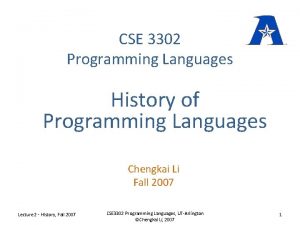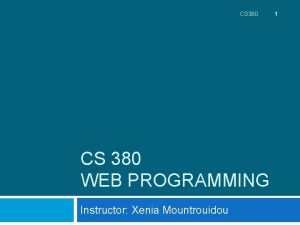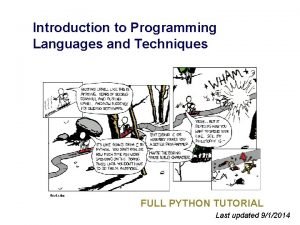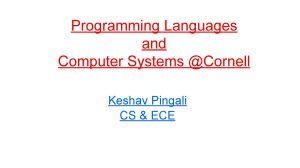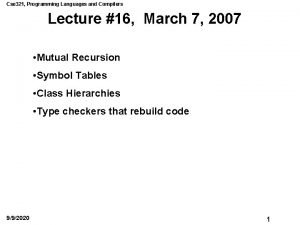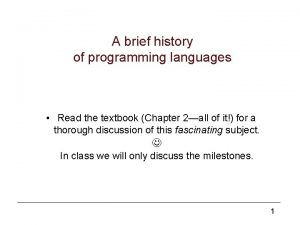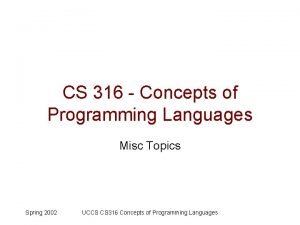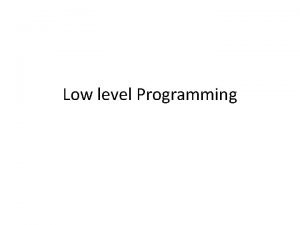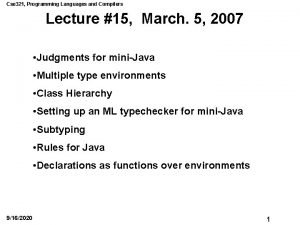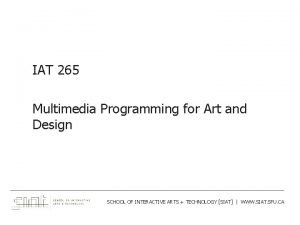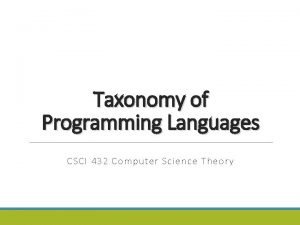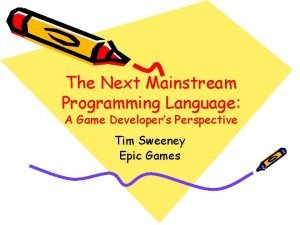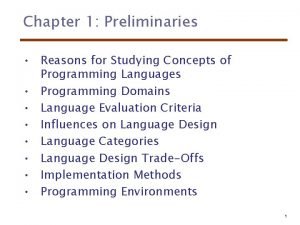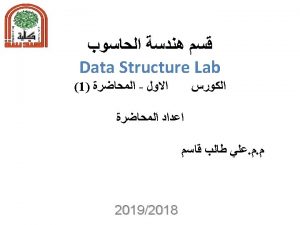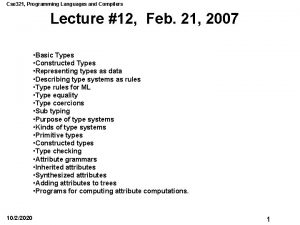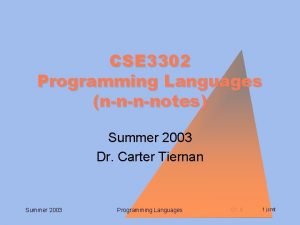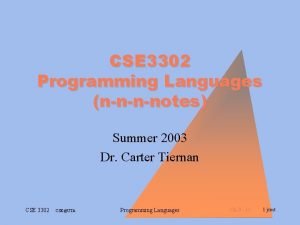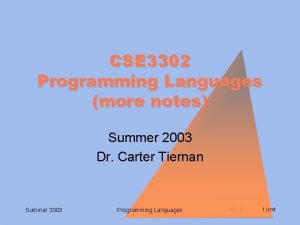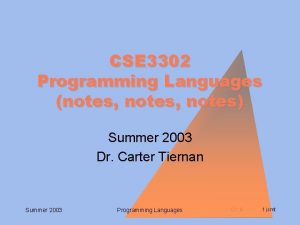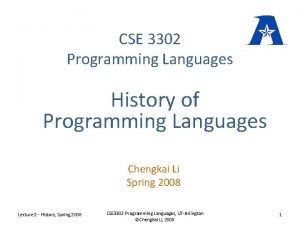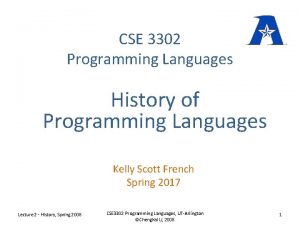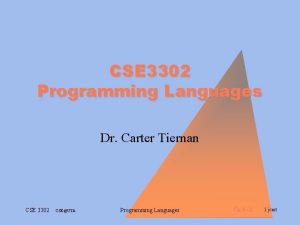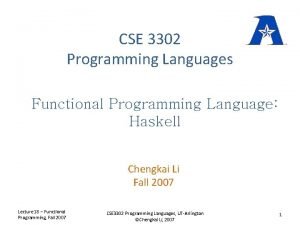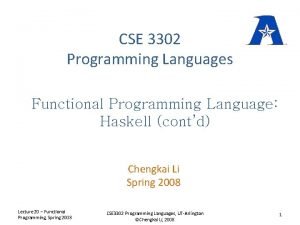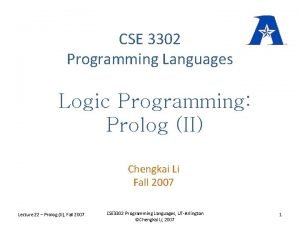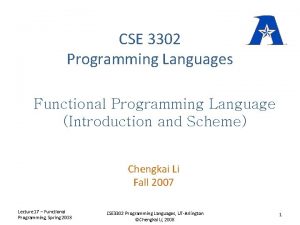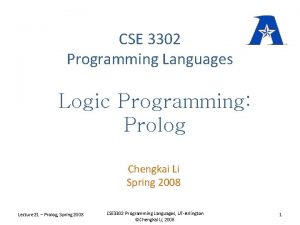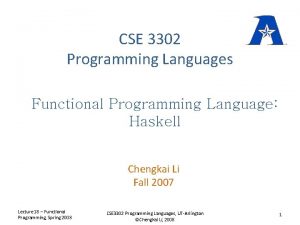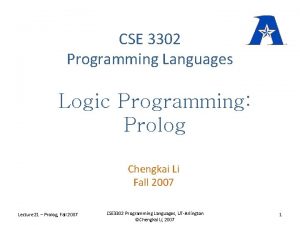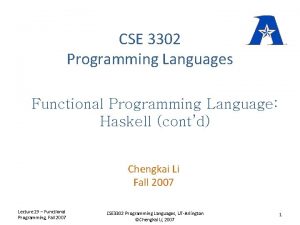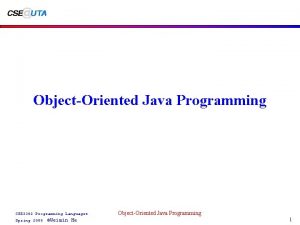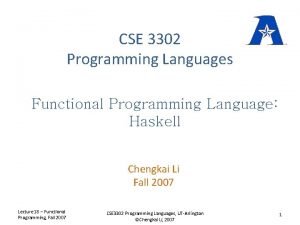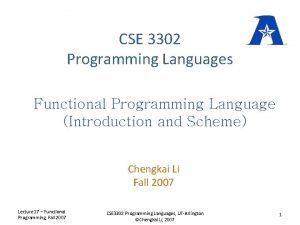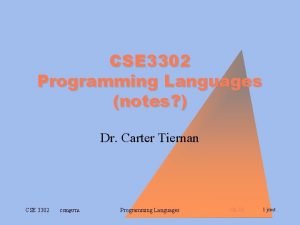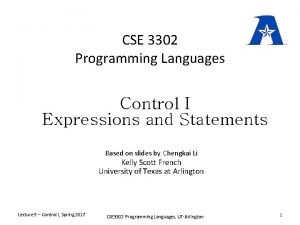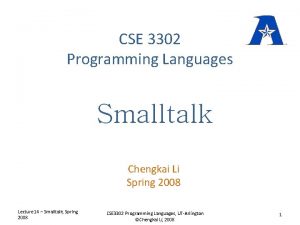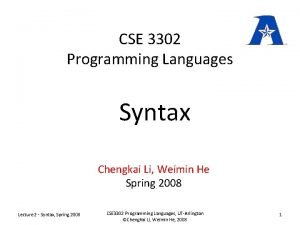CSE 3302 Programming Languages nnnnotes Summer 2003 Dr





























- Slides: 29

CSE 3302 Programming Languages (n-n-n-notes) Summer 2003 Dr. Carter Tiernan CSE 3302 CSE@UTA Programming Languages Ch. 9 - 11 1 jcmt

Functional Programming • List Processing - LISP • Complex interrelationships among data • Recursion in conjunction with conditional expressions • Primitive list-handling subroutines • Applicative language CSE 3302 CSE@UTA Programming Languages Ch. 9 - 11 2 jcmt

LISP • John Mc. Carthy • Function applications – Prefix (Polish) notation : flexibility – Fully parenthesized : no precedence rules • Symbolic data – Lists of symbols called atoms – List is ONLY data structure in LISP CSE 3302 CSE@UTA Programming Languages Ch. 9 - 11 3 jcmt

Lists • S-expressions – Function applications are evaluated – Quoted lists are treated as data • Programs and data represented the same way – Convenient for one program to generate and call for execution of another – Simple to write program manipulators CSE 3302 CSE@UTA Programming Languages Ch. 9 - 11 4 jcmt

LISP Execution • Usually interpreted and often interactive • Functions – Pure : compute a value only • eq, plus, difference, etc. – Pseudo : have side effects on computer state • set, defun, etc. CSE 3302 CSE@UTA Programming Languages Ch. 9 - 11 5 jcmt

Data Structures • Constructor : list • Primitives : atoms – Numeric (integer and floating point) • Many ops provided: arithmetic, increment, decrement, max, min, relational, predicates – Nonnumeric character strings • Limited ops: comparisons for equality • nil (false, empty set) • null is the test op CSE 3302 CSE@UTA Programming Languages Ch. 9 - 11 6 jcmt

Constructor • List – Surrounded by parentheses – Separated by blanks – Zero, one or more elements – Can contain lists – () equivalent to nil; called empty or null list CSE 3302 CSE@UTA Programming Languages Ch. 9 - 11 7 jcmt

Accessing Parts of a List • Car – Selects the first element of a list • Cdr – Returns all of a list except its first element • Car and Cdr are selectors • Car and Cdr can be combined to access interior parts of a list: ex. caadr CSE 3302 CSE@UTA Programming Languages Ch. 9 - 11 8 jcmt

Building a list • Cons – Creates a list from a first element and a list – Is the inverse of car and cdr – Example: • (car ‘(to be or not)) = to • (cdr ‘(to be or not)) = (be or not) • (cons ‘to ‘(be or not)) = (to be or not) CSE 3302 CSE@UTA Programming Languages Ch. 9 - 11 9 jcmt

Info Representation • Property lists – (p 1 v 1 p 2 v 2 … pn vn) where pn is the nth property and vn is the value of that property – P-lists give flexibility – Easy to define a function to get properties CSE 3302 CSE@UTA Programming Languages Ch. 9 - 11 10 jcmt

Info Representation • Association lists – ((a 1 v 1) (a 2 v 2) … (an vn)) – Handles properties which are flags or properties with multiple values CSE 3302 CSE@UTA Programming Languages Ch. 9 - 11 11 jcmt

Recursive list construction • Append two lists together – Identify simplest cases • (append ‘() L) = L • (append L ‘()) = L – Reduce other cases to the simplest cases • (append L M) = (cons (car L) (append (cdr L) M) – (defun append (L M) (if (null L)) M (cons (car L) (append (cdr L) M) )) CSE 3302 CSE@UTA Programming Languages Ch. 9 - 11 12 jcmt

Atoms • Created by mentioning them • Have properties and relations (p-list) – Print name / pname – putprop adds a property to an atom – apval denotes the binding of an atom to a value – set binds an atom – symbol-plist shows property list of an atom CSE 3302 CSE@UTA Programming Languages Ch. 9 - 11 13 jcmt

List representation • Linked list • Cells in the list have a right and a left – Right part points to next cell in list – Left part points to value of the cell • Data and programs both represented the same way – Program linked list called an expression tree CSE 3302 CSE@UTA Programming Languages Ch. 9 - 11 14 jcmt

List Primitives • Efficient – Car returns a left part – Cdr returns a right part – Cons requires storage allocation for new cell – Car, Cdr, and Cons do not change values • Sublists can be shared • Pseudo-functions alter lists – rplaca, rplacd – Have same drawbacks as aliasing CSE 3302 CSE@UTA Programming Languages Ch. 9 - 11 15 jcmt

Conditional expression • Cond – Mimics mathematical notation – Logical ops are defined in terms of the conditional • And & Or – Operands are evaluated sequentially – Conditional interpretation vs. strict CSE 3302 CSE@UTA Programming Languages Ch. 9 - 11 16 jcmt

Iteration • Performed by recursion • Reduction – Perform some op on every element of a list – Uses a binary function to reduce a list to a single value • Mapping – Apply a function to every element of a list – Returns a list of the results • Filtering – Forms a sublist containing all elements that satisfy some property CSE 3302 CSE@UTA Programming Languages Ch. 9 - 11 17 jcmt

Functional arguments • • • Abstracting out pattern Mapcar Filter Reduce Suppress details Simplify combination CSE 3302 CSE@UTA Programming Languages Ch. 9 - 11 18 jcmt

Recursive Interpreters • Arranged by cases – Atoms • Numeric • Nonnumeric – Quote – Conditional – Functions CSE 3302 CSE@UTA Programming Languages Ch. 9 - 11 19 jcmt

Interpreters • Primitive ops performed explicitly • User-defined functions – Evaluate parameters – Bind formals to actuals – Add bindings to environment – Evaluate function in environment CSE 3302 CSE@UTA Programming Languages Ch. 9 - 11 20 jcmt

Environment of evaluation • Arguments going to (apply f x a) (p. 380) – f the function - lambda expression – x the parameters - bound formals – a the environment - existing environment with the addition of the bound formals • Universal function CSE 3302 CSE@UTA Programming Languages Ch. 9 - 11 21 jcmt

Static scoping • Closure to indicate environment of definition function keyword – Instruction part (ip) - program, lambda expr. – Environment part (ep) - definition environment • (closure ip ep) • User-defined functions can be – Dynamically scoped lambda expressions – Statically scoped function closures CSE 3302 CSE@UTA Programming Languages Ch. 9 - 11 22 jcmt

Incompatible scope rules • Options – Adopt uniform static scoping – Use default static scoping but allow “special” dynamic scoping CSE 3302 CSE@UTA Programming Languages Ch. 9 - 11 23 jcmt

Storage reclamation • Explicit erasure – Work for programmers – Security problems (dangling pointers) • Automatic reclamation – Reference counts – Garbage collection CSE 3302 CSE@UTA Programming Languages Ch. 9 - 11 24 jcmt

Reference counts • Accessible cells are referenced • Reference count keeps track of how many other cells reference the current one • Count must be incremented and decremented correctly • Cells with zero count are added to the free list CSE 3302 CSE@UTA Programming Languages Ch. 9 - 11 25 jcmt

Reference counts • Cycles defeat reference counts – Cyclic reference boosts the count of each member plus one member has an outside reference. – If outside reference goes away, cycle still has references internally but no access from anywhere else in program – Allowing cycles is an open issue CSE 3302 CSE@UTA Programming Languages Ch. 9 - 11 26 jcmt

Garbage Collection • When storage becomes low, system starts up garbage collection • Mark and sweep process – Starting at roots mark all cells that can be reached recursively moving from each cell to its children – When all are marked, sweep through memory from top, free unmarked cells and reset flags on marked cells CSE 3302 CSE@UTA Programming Languages Ch. 9 - 11 27 jcmt

Garbage Collection • Wreaks havoc on execution time • Non uniform and unpredictable • Approaches to more efficiency include – Continuous garbage collection – Parallel CSE 3302 CSE@UTA Programming Languages Ch. 9 - 11 28 jcmt

LISP • AI - represent and manipulate complex interrelationships among symbolic data • Suited to ill-specified problems • Easy to manipulate LISP programs in LISP CSE 3302 CSE@UTA Programming Languages Ch. 9 - 11 29 jcmt
 Cse 3302
Cse 3302 Cse 340 principles of programming languages
Cse 340 principles of programming languages Vineeth kashyap
Vineeth kashyap Spring, summer, fall, winter... and spring cast
Spring, summer, fall, winter... and spring cast Language
Language Real-time systems and programming languages
Real-time systems and programming languages Xenia programming languages
Xenia programming languages Xkcd programming
Xkcd programming Introduction to programming languages
Introduction to programming languages Cornell programming languages
Cornell programming languages Programming languages
Programming languages Alternative programming languages
Alternative programming languages Cs 421 uiuc
Cs 421 uiuc Elsa gunter uiuc
Elsa gunter uiuc Brief history of programming languages
Brief history of programming languages Advantages and disadvantages of programming languages
Advantages and disadvantages of programming languages If programming languages were cars
If programming languages were cars Plc
Plc Low level programming language
Low level programming language Programming languages
Programming languages Types of programming languages
Types of programming languages Iat 265
Iat 265 Multithreading program in java
Multithreading program in java Taxonomy of programming languages
Taxonomy of programming languages Mainstream programming languages
Mainstream programming languages Reasons for studying concepts of programming languages
Reasons for studying concepts of programming languages Procedural programming languages
Procedural programming languages Middle level programming languages
Middle level programming languages Programming languages
Programming languages Types of programming languages
Types of programming languages
